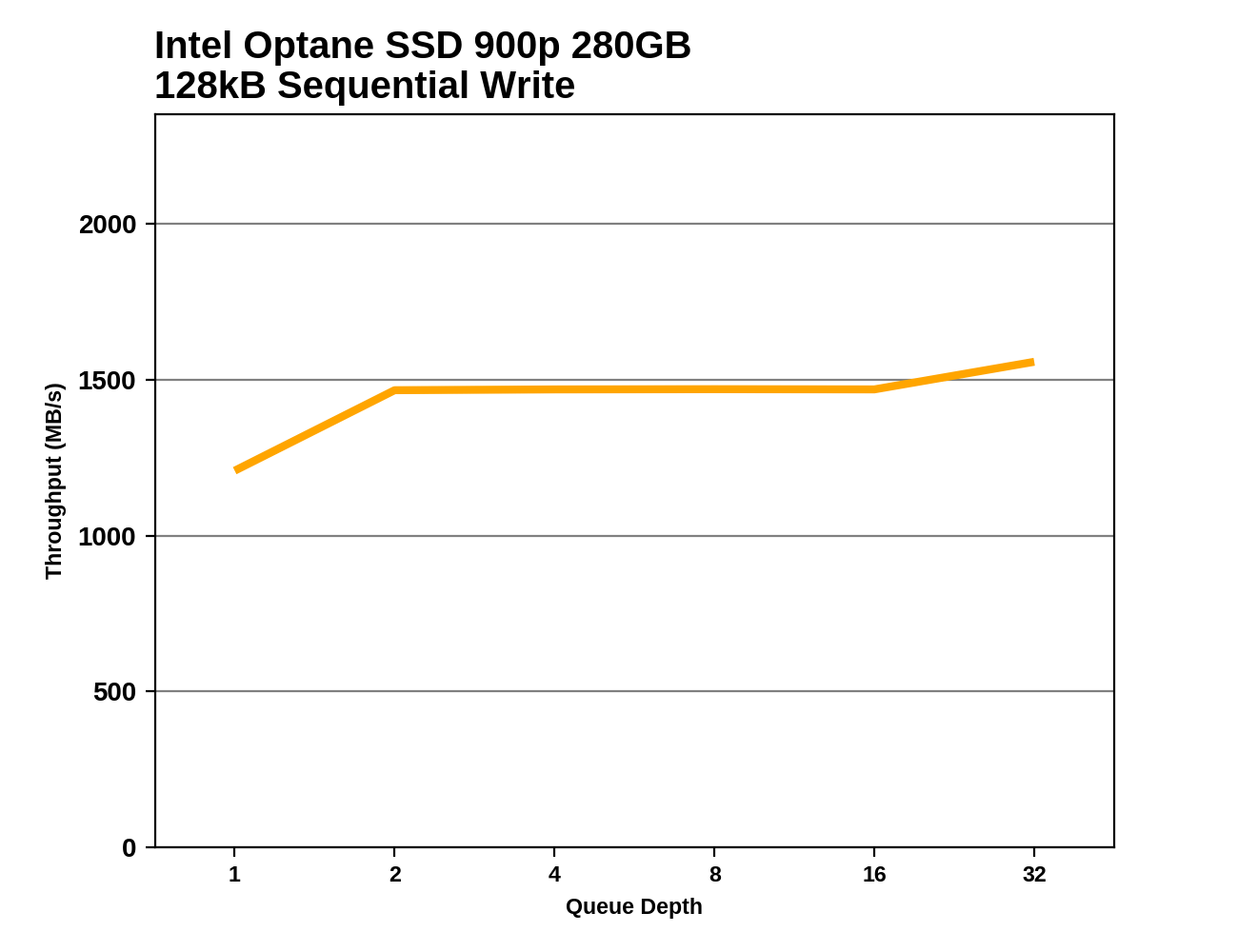The Intel Optane SSD 900P 280GB Review
by Billy Tallis on October 27, 2017 9:30 AM ESTSequential Read Performance
Our first test of sequential read performance uses short bursts of 128MB, issued as 128kB operations with no queuing. The test averages performance across eight bursts for a total of 1GB of data transferred from a drive containing 16GB of data. Between each burst the drive is given enough idle time to keep the overall duty cycle at 20%.

The burst QD1 sequential read performance of the Intel Optane SSD 900P falls in between the Samsung 960 PRO and 960 EVO. Samsung's fastest outperforms the Optane SSD by about 11%.
Our test of sustained sequential reads uses queue depths from 1 to 32, with the performance and power scores computed as the average of QD1, QD2 and QD4. Each queue depth is tested for up to one minute or 32GB transferred, from a drive containing 64GB of data.

On the longer test of sequential read performance, the Optane SSD holds on to a commanding lead after the flash-based SSDs mostly slow down relative to their burst performance.
 |
|||||||||
Both Optane devices show a jump in performance from QD1 to QD2, after which their performance holds steady. Samsung's 960s show very minor performance increases with queue depth, and at the highest queue depths the Intel SSD 750 comes closest to catching up to the Optane SSD.
Sequential Write Performance
Our test of sequential write burst performance is structured identically to the sequential read burst performance test save for the direction of the data transfer. Each burst writes 128MB as 128kB operations issued at QD1, for a total of 1GB of data written to a drive containing 16GB of data.

Samsung's 960 PRO and EVO drives all outperform the Intel Optane SSD 900P on the burst sequential write test, by up to 16%.
Our test of sustained sequential writes is structured identically to our sustained sequential read test, save for the direction of the data transfers. Queue depths range from 1 to 32 and each queue depth is tested for up to one minute or 32GB, followed by up to one minute of idle time for the drive to cool off and perform garbage collection. The test is confined to a 64GB span of the drive.

On the longer sequential write test, the Optane SSD loses ground to Samsung's three fastest SSDs but everything else slows down even more.
 |
|||||||||
Almost all of the SSDs in this bunch reach their full sequential write speed at QD2, and they are mostly differentiated by their speeds once saturated. A few drives show some unevenness during the later portions of the test, but the Optane SSD has just a minor blip in its favor at the end of the test.










205 Comments
View All Comments
melgross - Friday, October 27, 2017 - link
You’re not as objective as you proclaim. If you were, you’d be more in line with what the conslucion says, which is that for many things there isn’t much of an advantage, but for others there is, and most of the reas\OSs aren’t the fault of this, but rather, old concepts in storage.ddriver - Friday, October 27, 2017 - link
So in order to be objective, I will have to echo what AT - a heavily pro-intel biassed website says about it? Yep, that sounds legit :)It would seem you confuse objectivity for conformity.
r0gue6 - Friday, October 27, 2017 - link
I can tell you are extremely bias simply because you use ignorant words like "hypetane" unironically.ddriver - Friday, October 27, 2017 - link
Hypetane is perfectly suited. The product turned out to be 90% hype, and it also rhymes. What more could anyone possibly want?And calling things for what they are is the very essence of objectivity.
shabby - Friday, October 27, 2017 - link
It is 1000 times faster... at die level, pcie and drivers show it down. /intel pr proddriver - Friday, October 27, 2017 - link
Sure, if you say so. I mean it is obviously saturating and exceeding the PCIE bandwidth and crippled by the PCIE latency.Oh wait, it isn't. Maybe it is intel's controller then. Who knows. I mean aside from you ;)
lmcd - Friday, October 27, 2017 - link
Ironic, because you aren't the king of anything.voicequal - Saturday, October 28, 2017 - link
It's pretty clear Intel's performance claims were speaking of the cell level (NAND vs 3D Xpoint), not the system level (SSD, SYSmark, etc).Drumsticks - Friday, October 27, 2017 - link
Not that anybody will ever convince you that anything Intel can do is good, but here is a graph of how much endurance the 480GB Optane SSD has in terms of TBW compared to the other Pro SSDs.https://www.pcper.com/files/imagecache/article_max...
ddriver - Friday, October 27, 2017 - link
Cool, even if not real-world maxing out but intel's claim, I am willing to assume that intel won't lie on the spec sheet of an actual product.But then again, I am going to refer you to this little gem:
http://images.hardwarecanucks.com/image/akg/Storag...
The rated number is still almost 50 times less than what intel claimed officially. 45 times less is pretty significant IMO. Imagine getting a job where they promise you 20k $ a month, and end up paying you 450$ instead. Not cool. In light of that, I wouldn't say my criticism is ungrounded.
For me personally, 20 times better endurance than NAND is pretty good, good enough to justify the purchase even at the present price.
Now if only intel started out with a 20x claim instead of the 1000x claim, I wouldn't have any legit reason to bash that product. And maybe if more call intel on their BS, they just might cut it. And I don't think that will be a bad thing.